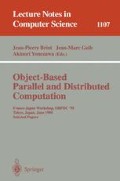Abstract
In this paper, we propose new concepts, Evolutional Agents and Field Oriented Programming. The main purpose of the work is to provide a framework for building software which adapts to changes of requirements autonomously.
Such adaptability is essential in open networks. Meanwhile in networks, many free applications exist and have a great potential for software reuse. We focus on the point and incorporated concurrent object oriented model with meta-architecture and a concept called field. In our model, evolutional agents are autonomous objects with meta-architecture which adapts to changes by acquiring components scattered over networks as their own functions. Fields are receptacles of software components in networks. Agents evolve into adaptive ones by moving among fields and acquiring components from the fields.
Flage language is a framework for describing such a software architecture. Moreover, formal semantics of agent evolution in Flage is proposed because it is necessary to rigorous verification of specifications and programs in software development in practical situations of industrial fields. The semantics of Flage is based on an algebraic framework to enable automatic verification procedures.
Preview
Unable to display preview. Download preview PDF.
References
G. Agha. ACTORS: A Model of Concurrent Computation in Distributed Systems. MIT Press, 1986.
S. Chiba and T. Masuda. Designing and Extensive Distributed Language with Meta-Level. In ECOOP'93, pp.482–501, 1993.
O. Danvy and K. Malmkjær. Intentions and extensions in a reflective tower. In Proc. of 1988 ACM Conference on Lisp and Functional Programming, pp. 327–341, 1988.
A. Davis. The digital valet, or Jeeves goes online. In EDUCOM Rev, vol.29, no.3, pp.44–46, 1994.
J. Ferber. Computational Reflection in Class based Object Oriented Language. In OOPSLA'89, pp.317–326, 1989.
D. Friedman and M. Wand. Reification: Reflection without metaphysics. In Proc. 1984 ACM Conference on Lisp and Functional Programming, pp. 348–355, 1984.
M. Kurihara and A. Ohuchi. An algebraic specification and an object-oriented implementation of a reflective language. In A. Yonezawa and B. C. Smith, editors, Reflection And Meta-Level Architecture, Proceedings of the International Workshop on New Models for Software Architecture, pp. 137–142, 1992.
H. Lieberman. Using Prototypical Objects to Implement Shared Behavior in Object Oriented Systems. In OOPSLA '86, pp.214–223, 1986.
J. Meseguer. Rewriting as a unified model of concurrency. In Proceedings of the CONCUR'90 Conference, Amsterdam, August 1990, LNCS 458, pp. 384–400, 1990.
P. Maes. Concepts and Experiments in Computational Reflection. In OOPSLA '87, pp.147–155, 1987.
S. Nakajima. What makes a language reflective and how? In A. Yonezawa and B. C. Smith, editors, Reflection And Meta-Level Architecture, Proceedings of the International Workshop on New Models for Software Architecture, pp. 125–136, 1992.
H. Okamura and et al. Metalevel Decomposition in AL-1/D. In Object Technologies for Advanced Software, LNCS742, pp.110–127, 1993.
B. C. Smith. Reflection and semantics in lisp. In Proc. POPL'84, pp. 23–35, 1984.
M. Wand and D. Friedman. The mystery of the tower revealed: A nonreflective description of the reflective tower. In P. Maes and D. Nardi, editors, Meta-Level Architectures and Reflection, pp. 111–134. North-Holland, 1988.
T. Watanabe and A. Yonezawa. Reflection in an Object-Oriented Concurrent Language. In OOPSLA'88, pp.306–315, 1988.
Author information
Authors and Affiliations
Corresponding author
Editor information
Rights and permissions
Copyright information
© 1996 Springer-Verlag Berlin Heidelberg
About this paper
Cite this paper
Tahara, Y., Kumeno, F., Ohsuga, A., Honiden, S. (1996). Formal semantics of agent evolution in language flage. In: Briot, JP., Geib, JM., Yonezawa, A. (eds) Object-Based Parallel and Distributed Computation. OBPDC 1995. Lecture Notes in Computer Science, vol 1107. Springer, Berlin, Heidelberg. https://doi.org/10.1007/3-540-61487-7_36
Download citation
DOI: https://doi.org/10.1007/3-540-61487-7_36
Published:
Publisher Name: Springer, Berlin, Heidelberg
Print ISBN: 978-3-540-61487-6
Online ISBN: 978-3-540-68672-9
eBook Packages: Springer Book Archive

